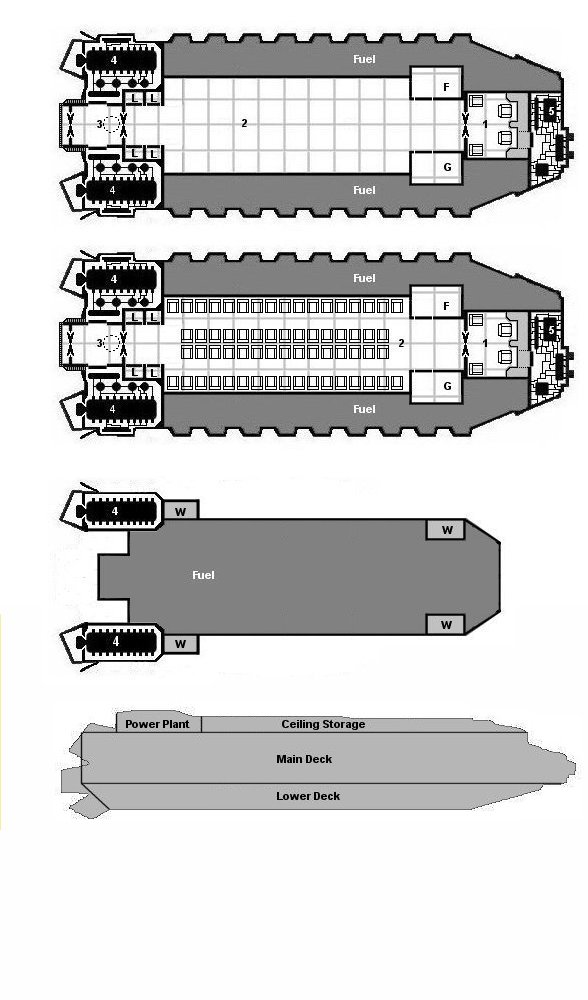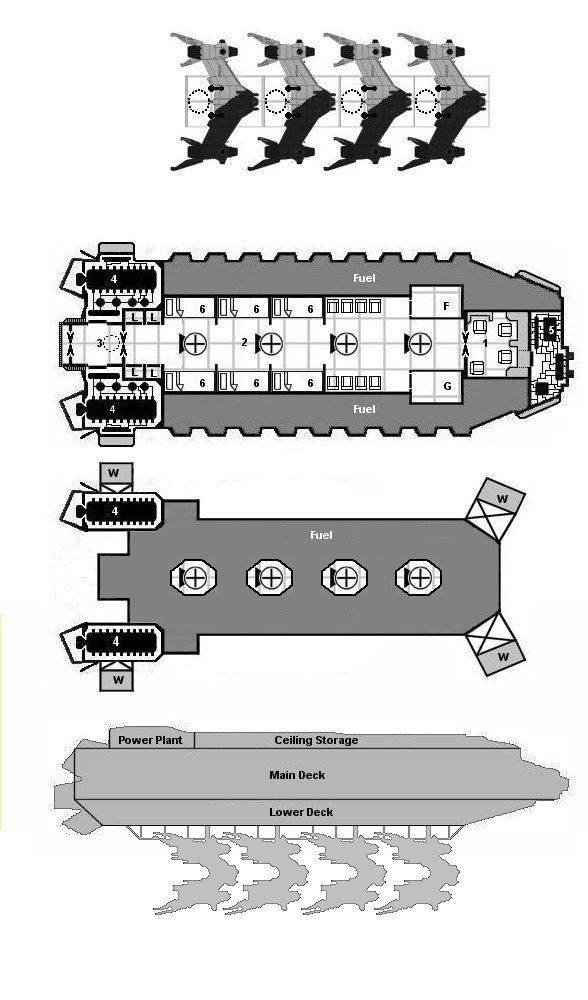Earth Alliance Heavy Shuttle
This article originally appeared in the July 2012 issue.
The STG-21 Nordkapp Military Heavy Lift Shuttle was an expensive failure as far as the Earth Alliance was concerned. Originally designed as a heavy lift supplement to the Light Shuttle fleet; it was slow, ungainly, and didn’t live up to its potential of ‘bigger is better’. Of the 1200 originally planned, only 352 were ever produced; of those 38 have been scrapped, 40 have been converted to Fighter Transit Shuttles and the remainder are in service with the largest ships in the fleet: Explorer ships and carriers.
| Earth Alliance Light Shuttle (Cargo/Personnel Shuttle Variant) | Tons | Price | ||
|---|---|---|---|---|
| Hull | 100T Standard |
Hull 2 Structure 2 |
100 | 2 |
| Armour | None | 0 | 0 | |
| Manoeuvre Drive | Reaction Drive B | Thrust 4 | 3 | 8 |
| Power Plant | Power Plant A | 2 | 4 | 8 |
| Bridge | 4 Crew | 10 | 0.5 | |
| Computer | Model 2 | Rating 10 | 0 | 0.16 |
| Electronics | Standard | -4 DM | 0 | 0 |
| Weapons | None | 0 | 0 | |
| Fuel | 35T + 2T (Fusion Plant 14 days endurance) | 37 | 0 | |
| Software | Manoeuvre/0, Library/0 | 0 | 0 | |
| Extras | Airlock, 6 Firmpoints | 1.5 | 0.6 | |
| Cargo | 44.5T (Personnel Variant: 12.5T plus Seats/Cramped×64) | 44.5 | 0/1.92 | |
| Total Tonnage and Cost | 120 | 19.26/21.18 | ||
Features
Firmpoints
Each Shuttle is equipped with three pairs of Firmpoints (0.5T, 0.2 MCr per pair) which can be used to attach different types of modules to the shuttle. Each pair of Firmpoints are on either side of the shuttle and must use the same type of attached module (for example, you could fix two fuel modules to the front pair, two cargo modules to the middle pair and another two fuel modules to the rear pair). If you have any modules attached to a shuttle, the hull counts as being distributed rather than standard. The two most common modules used are 5T cargo and fuel modules (not interchangeable – you can’t use the cargo ones for fuel and vice-versa), which cost 0.01 MCr empty, have negligible mass and hold either 5T of cargo or fuel respectively.
Landing Struts
The STG-21 Shuttles are designed to operate from ships, stations and prepared landing areas. Because of this, the landing struts are unsuitable for landing on unprepared or uneven ground. An ‘All-Terrain’ extendable landing pad system is available, taking up 2T of cargo space at a cost of 0.5 MCr.
Other Features: Each STG-21 is usually equipped with two or more lockers for EVA suits (located near the airlock), as well as many small compartments located in the overhead area or under seats to store light hand luggage. The galley is suitable for preparing light meals, snacks, and hot or cold drinks suitable for zero-g consumption from pre-packaged stores.
Standard Variants
Though not modular, the STG-21 lends itself to different configurations quite readily and there are several different variants of this shuttle available as standard. The most common ones are:
STG-21b Armed Military Shuttle: removes 1T of cargo in exchange for a single light pulse cannon (fixed forward) for +1.1 MCr.
STG-21p Crew Shuttle: this configuration converts 32T of cargo space into cramped seating for 64 passengers (uses 0.5T and 0.03 MCr per passenger) at a cost of +1.92 MCr. This configuration can be used with the STG-21b Armed Military Shuttle.
STG-21f Fighter Transit Shuttle: This configuration removes 30T of cargo space and adds six double-occupancy bunks (four flight crew, eight support crew), an all-terrain landing system and four (30T) docking clamps at a cost of + 5.5 MCr. It is designed to enable ships and stations to be re-armed with fighters quickly and efficiently, and has a flight control station on the bridge for launching and recovering fighters as well as in-flight ops. This configuration is suitable only for the Starfury fighters and can not be used with the newer Thunderbolt fighters. It is believed that Psi Corps has at least 4 of these Shuttles to support the Black Omega fighter wing.
Deck Plan Key (for all variants pictured)
1. Cockpit/Control Cabin.
2. Main cargo or transport cabin.
3. Airlock with fold-down powered ramp and ceiling access to Power
Plant.
4. Engines (access panels located in airlock area).
5. Sensors and Computer/Electronics (access panel in crawl-space under
co-pilot control console).
6. Double bunks.
F. Fresher.
G. Galley.
L. Locker for EVA suit.
W. Landing strut well.
 Freelance
Traveller
Freelance
Traveller
